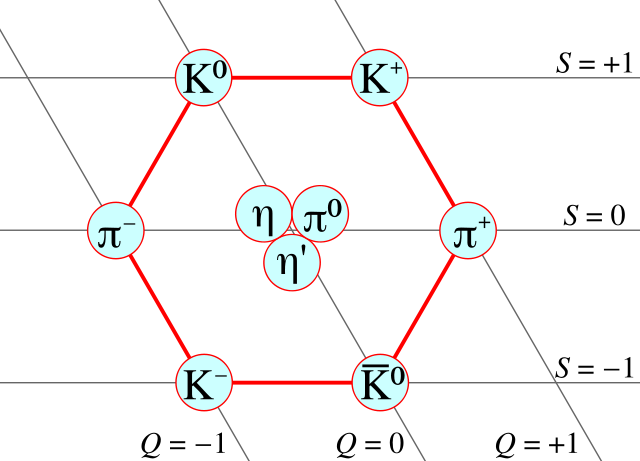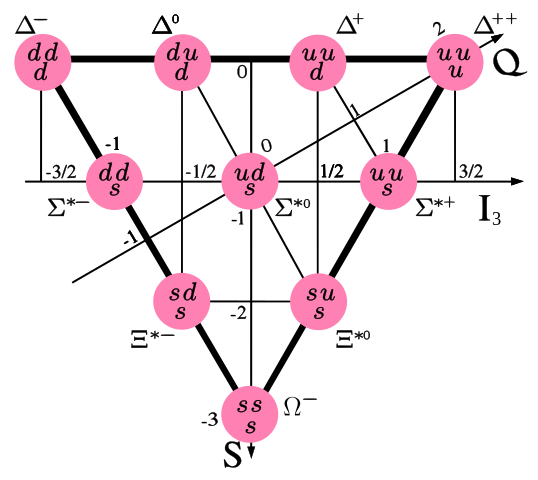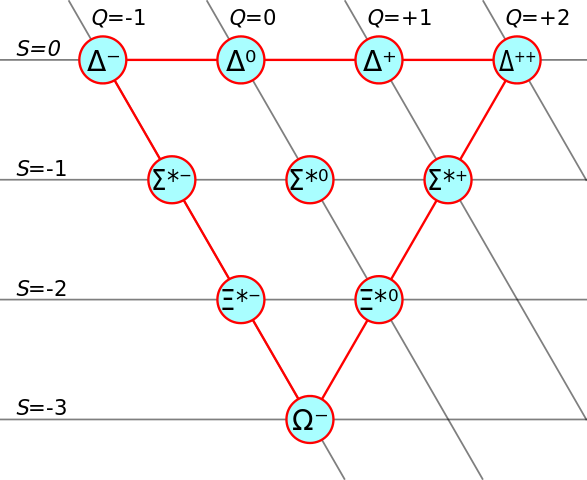PARTICLE PHYSICS: The Search For Order And The Classification of Particles.
This is a sequel to my last post on PARTICLE PHYSICS: Discovery of Particles and the Existence of Energy, Matter and Antimatter. In this post, I will explain the problems faced by physicists in
putting all particles in order, the new fundamental properties, patterns of behaviour,
and breaking the law of Strangeness conservation.
The problem faced by researchers was how to put all these new particles into some sort of order, and perhaps find out why they existed. Researchers started off by naming them with Greek letters, more or less randomly as they turned up. These are a few examples:
μ - mu ‘mesons’ or muons, π - ‘pi’ mesons or pions, K - kappa mesons or kaons, K (kappa – a kaon), Λ - lambda particles, Ξ - xi particles, Σ - sigma particles, Ω - omega particles.

The spin-0 nonet of mesons. User:E2m, User:Stannered, Public Domain
You don’t need to remember the details of these particles, but should recognise them when you get to see them. The basic properties of matter were well known to the researchers, but more properties had to be discovered before a clear system of classification was produced. These basic properties are charge and mass.
CHARGE: This is either positive or negative. It is also ‘quantized’: both positive and negative charge on ordinary particles come in simple multiples of the elementary charge, -1e or +1e, of value +/-1.6 × 10-19 C. However, charge is no great help in solving the problem of classifying so many particles.
MASS: Mass seemed a good basis for classification, and particles discovered in the 1940s and 1950s were put into three groups mainly by mass according to the table below.
| Name | Mass | Examples |
| Mesons | medium | pions, kaons |
| Baryons | heavy | protons, neutrons, lambda, sigma, xi |
| Leptons | light | electrons, muons, neutrinos |
There were problems with this grouping: a muon
is nearly as massive as a pion, for example, although as we shall see they
belong to completely different families of particle. Also, new particles were discovered,
such as some new mesons (middleweights) which were heavier than the proton.
But, as we shall see next, the groups had properties other than mass that made
them fundamentally different.
NEW FUNDAMENTAL PROPERTIES
Charge and mass were not enough to make the distinctions between all the particles found, so workers identified other common properties. These properties are just as fundamental and mysterious as charge and mass, and physicists have given them weird names including charm, bottomness, baryon, number and strangeness. Using these properties, physicists have been able to simplify what has been called the particle zoo, as we shall see later. One such property is whether the particle responds to different kinds of force.
MATTER AND FORCES: HADRONS AND LEPTONS
We are familiar with the fact that charge is acted upon by electromagnetic forces, and that mass is acted upon by gravity. A key to identifying the differences between particles was the way they were affected by these and other forces. Protons in a nucleus are affected by electromagnetic forces and by gravity. But they stay inside the nucleus, in spite of the strong electric force of repulsion due to their positive charges, because there is another, stronger force holding them together. This is the strong nuclear force.

All particles that ‘feel’ the strong nuclear force are called hadrons, subdivided into mesons and baryons. Most particles that do not ‘feel’ the strong force are called leptons. This distinction neatly separated most particles into two significant groups: pions are hadrons, and ‘feel’ the strong nuclear force, while electrons and muons are leptons (as is shown below) and are unaffected by the strong force. (This broad classification could be developed further, whereas the grouping of the table above could not.)
| Hadrons | Non-hadrons |
| Mesons, e.g. pions, kaons, eta mesons | leptons, including electrons, muons, neutrinos |
| Baryons, e.g. protons, neutrons, omega, sigma and lambda particles | photons, gravitons (if they exist) |
The lepton family is described in more detail
in the table. Another important difference between hadrons and leptons is that
leptons have no substructure – they are (as far as we know) genuinely
fundamental particles – while hadrons are built from even smaller (fundamental)
particles called quarks. Most hadrons and leptons are unstable: they
very quickly decay into other particles, and finally end up as the only stable
particles in the Universe – protons, electrons and neutrinos. Even the neutron
is unstable, since outside a nucleus it decays with a half-life of about 11
minutes to a proton, an electron and an antineutrino: n → p + e‑ + ṽ
PARTICLES AND ANTIPARTICLES
Each hadron has its antiparticle, for example: proton and antiproton, p+ and p-, neutron and antineutron n and ñ, kappa meson (or kaon), K+ and K-. Antiparticles are often represented by using a bar over the symbol, as for the antineutron, especially when they have no opposite charge.
THE WEAK NUCLEAR FORCE
As well as being affected by the electromagnetic force, charged hadrons are affected by a force called the weak nuclear force and, since they all have mass, they are affected by gravity. The weak force seems the most mysterious of all the forces. Like the strong force, it acts over a very short range. However, modern theory shows that when particles have a high enough energy, the weak force and the electric force become the same electroweak force. The weak force seems to work as one quark changes into another.
LEPTONS
Leptons are generally much less massive than hadrons (Greek: hadron = heavy, lepton= small). Leptons are affected by three of the four fundamental interactions (forces): the electromagnetic (if charged), the weak and gravity. There are three kinds of lepton: electrons e, muons μ, and tauons τ. Each of these is associated with its own kind of neutrino v.
Electrons and neutrinos are stable particles, but both muons and tauons decay. Their decay is due to the weak force, so lifetimes are much longer than for the unstable hadrons. The tauon is much more massive than the other leptons and has enough mass-energy to decay into hadrons. Each property of a particle is in general associated with a number, which helps to explain the reactions in which they are involved. For example, charge is either +1 or -1.The number associated with ‘lepton-ness’ is the lepton number (+1 for leptons, -1 for antileptons).
LOOKING FOR PATTERNS OF BEHAVIOUR
So far, we have seen how particles are classified in terms of well-known properties, like mass and charge, and their response to forces. But the key to the fundamental nature of particles was in investigating what happens and what does not happen when particles interact or otherwise change, either naturally by spontaneous decay or when they interact at high energies.
THE RULES OF BEHAVIOUR
Fundamental particles must obey the basic ground rules of physics, which should be well known. These are:
- Momentum conservation. In any interaction between particles in a system, the total momentum must stay constant.
- Mass-energy conservation. In any interaction between particles in a system, mass-energy must neither be created nor destroyed.
- Charge conservation. In any interaction between particles in a system, the total electrical charge in the system must not change.
The following examples illustrate these rules.
Example 1. Neutron decay
n → p + e- + ṽe
The neutron has mass – energy of 939.6 MeV, the proton has 938.3 MeV and the electron 0.5 MeV. The neutron can thus change into the particles on the right with an energy of about 0.8 MeV left over to be shared by the kinetic energy of the products and the creation of the antineutrino. The neutron has zero charge and so the sum of the charges on the products is also zero.
Example 2. Proton-antiproton annihilation
p + ῤ→ π+ + π- + π°
This reaction clearly conserves charge. The combined mass-energy of the protons is 1876 MeV. The mass-energy of each charged pion is 140 MeV, with 135 MeV for the neutral pion. Since the mass-energy of the protons is more than enough to produce the total mass of the pions (415 MeV), they fly off at very high speeds, in the directions that conserve momentum.
Example 3. When the expected doesn’t happen
Particle physicists soon realised that there were some possible changes that did obey the three basic conservation laws but which never actually occurred, even when enough energy was supplied. For example, a proton did not spontaneously decay into a positron and a neutral pion, even though charge, energy and momentum could all be conserved.
p ≠ e+ + π°
This is just as well, otherwise all protons would eventually decay and the atomic nucleus – hence atoms, chemistry, life, stars – could not exist!
WHY SOME CHANGES COULD NOT HAPPEN: THE DISCOVERY OF BARYON NUMBER
Many other proposed changes were never observed in practice. So physicists decided that there must be some sort of ‘charge’ that would not be conserved by these changes – the equations would not balance. A theory was proposed that particles possess (or lack) another property that must be conserved. It was a quality that, for example, a proton possessed but that neither electrons nor pions did. Evidence built up that this new kind of charge was possessed only by the heavier particles, the baryons. Unlike electric charge, there was no force associated with it. But like electric charge it came in same-size ‘chunks’. It is called baryon number, B.
The proton and neutron were given baryon number +1, and electrons, neutrinos, positrons and pions had baryon number 0. Thus, proton decay could not occur because baryon number would not be conserved, the two sides in Example 3 did not balance:
baryon equation: +1 ≠ 0
But when a neutron decays into a proton (Example 1 above), baryon number is conserved because the neutron also has a baryon number of +1. Now look back at the reaction in Example 2, in which two baryons (proton and antiproton) are converted to pions. Here the right side is entirely of pions, and so has zero baryon number. Thus the left side must also have zero baryon number. This can be true only if the antiproton has a negative baryon number (B = -1). Mesons and baryons are grouped together as drons. But note that mesons have a baryon number of 0, Leptons also have baryon number 0 but have their own conserved property, lepton number L. Leptons must have lepton number +1 or -1. To conserve lepton number, when leptons are made out of non-leptons they are made in pairs:
π- → μ- + ṽμ
Pions are not leptons, so the left side of the equation has a lepton number 0. On the right side is a muon of lepton number +1 and a muon antineutrino with a lepton number -1.

Bosons-Hadrons-Fermions. Hugo Spinelli, Public Domain
MORE NON-EVENTS LEAD TO MORE NEW PROPERTIES
Identifying reactions that seemed never to happen became an important tool in classifying particles. This approach led to strange particles – particles wth a conserved property called strangeness. This was to be explained by the theory of quarks, which dramatically simplified the task of classifying particles.
STRANGENESS AND TIME
Reactions that involve the strong nuclear force seemed to happen on a very short time scale, typically 10-23 s. This is the time it takes for the fastest possible effect – the strong interaction – to cross a nucleus at the speed of light. A typical reaction involving strongly interacting particles takes this very short time. For example:
p + π- →K0 + Λ time = 10-23 s
The Λ
(lambda) particle is unstable and breaks up – but oddly, it does so in a time
of about 3 × 10-10 s.
Let us put this into an everyday time scale. When you drop a china cup on to a
hard floor, it breaks up in less than a millisecond. (For a rough estimate,
consider how long it takes a shock wave travelling at the speed of sound to
cross a cup. The cup usually breaks into several pieces, all produced at much
the same time, all of random sizes.)
Both of the times for the particle reactions are very short. But one is 1013 times longer than the other. On the cup scale of time, it was as if you dropped a cup, which immediately (at least, in 10-4 s) broke into two large pieces. Then, three years later, these two pieces broke up into lots of smaller pieces.
The new exceptionally long-lived particles were not clearly identified by mass, charge and baryon number, so they were simply called strange particles and labelled as K (kappa – a kaon), Λ (lambda), Σ (sigma), Ξ (xi) and Ω (omega).
The fundamental ‘charge’ or property called strangeness, symbol S, was needed to explain this behaviour. Particles can have strangeness numbers from +3 to -3. This introduces the idea of ‘threeness, which will be explained below.
The strangeness of interactions is conserved only for reactions in which the strong force is important. For example, we can produce the larger baryons, called hyperons, by colliding an electron and a positron at very high speeds. The collision has enough energy to make a large number of particles. When this happens, if hyperons are produced, they have to be as pairs with equal but opposite strangeness:
e- + e+ + a lot of mass-energy → Λ° + Λ-° plus other particles
The ordinary baryons (protons and neutrons) have zero strangeness. Strange particles Λ and Σ have negative strangeness, and their antiparticles have positive strangeness.

On breaking the law of strangeness conservation
Some conservation rules work only when the strong force is involved, others only for the weak force. One rule is the conservation rule for strangeness. It has been found that strangeness-carrying particles can decay into particles with zero strangeness, thus breaking the conservation law. But they can only do this via the weak interaction, and when they do, they can only change the total strangeness number by just one step at a time. For example, a xi hyperon (also called a cascade hyperon) first decays into a lambda hyperon in a weak interaction, gaining strangeness of +1. Then the lambda hyperon changes into hadrons (particles responding to the strong force but here interacting via the weak force) of strangeness 0, again with a strangeness change of unity.
Step 1: Ξ- → Λ0 + π-
S = -2 S = -1 S = 0 ΔS = +1
Step 2: Λ0 → π- + p+
S = -1 S = 0 S = 0 ΔS = +1
Till next time, I remain @emperorhassy.
Thanks for reading.
REFERENCES
https://www.britannica.com/science/subatomic-particle/Four-basic-forces
http://nattrass.utk.edu/Phys250Spring2019Web/modules/module%206/particle_classification.htm
https://en.wikipedia.org/wiki/List_of_particles
https://courses.lumenlearning.com/physics/chapter/33-4-particles-patterns-and-conservation-laws/
http://physicsnet.co.uk/a-level-physics-as-a2/particles-radiation/particles-antiparticles-photons/
https://en.wikipedia.org/wiki/Antiparticle
https://www.britannica.com/science/lepton
https://www.universetoday.com/46935/leptons/
https://en.wikipedia.org/wiki/Lepton
https://hepweb.ucsd.edu/ph110b/110b_notes/node63.html
http://www-pnp.physics.ox.ac.uk/~barra/teaching/hadrons.pdf
https://en.wikipedia.org/wiki/Baryon_number
https://www.sciencedirect.com/topics/physics-and-astronomy/strangeness
https://www.sciencedirect.com/topics/chemistry/baryon
https://courses.lumenlearning.com/physics/chapter/33-4-particles-patterns-and-conservation-laws/
https://blogs.loc.gov/catbird/2017/02/date-and-time-please-the-strangeness-of-time-stamped-poetry/
http://www.strangemag.com/timetravel/spacetime.html
https://en.wikipedia.org/wiki/Strangeness
Hello,
Your post has been manually curated by a @stem.curate curator.
We are dedicated to supporting great content, like yours on the STEMGeeks tribe.
If you like what we are doing, please show your support as well by following our Steem Auto curation trail.
Please join us on discord.
Congratulations @emperorhassy! You have completed the following achievement on the Steem blockchain and have been rewarded with new badge(s) :
You can view your badges on your Steem Board and compare to others on the Steem Ranking
If you no longer want to receive notifications, reply to this comment with the word
STOPTo support your work, I also upvoted your post!
Very nice summary, thank you!
Thanks, @chappertron.
This post has been voted on by the SteemSTEM curation team and voting trail. It is elligible for support from @curie and @minnowbooster.
If you appreciate the work we are doing, then consider supporting our witness @stem.witness. Additional witness support to the curie witness would be appreciated as well.
For additional information please join us on the SteemSTEM discord and to get to know the rest of the community!
Thanks for having used the steemstem.io app and included @steemstem in the list of beneficiaries of this post. This granted you a stronger support from SteemSTEM.
Thanks! Particle physics is a very fasinating subject!!